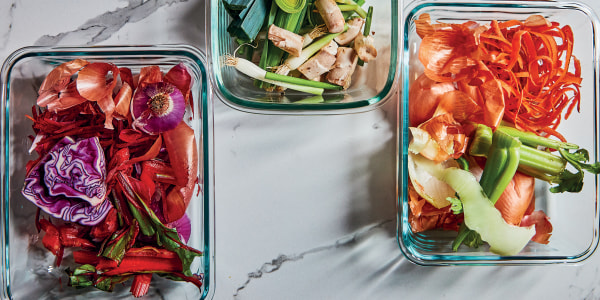How long will a given piece of produce last in the fridge? The answer, unfortunately, is it depends: It depends on your particular fridge (its age and effectiveness) and the climate where you live, as well as the age of the produce and how it was handled before you even brought it home.
This guide shares the science behind produce shelf life and the storage techniques I’ve found work best.
1. Temperature
When produce is stored in a cold environment, the other nine freshness factors can’t cause as much damage; things like respiration and microorganism activity are slowed down. The inverse is true as well. If your produce is stored in warm conditions, that extra heat speeds up the life cycle and accelerates produce death and decay.
2. Humidity
Fresh produce has an incredibly high water content. The minute a piece of fruit or a vegetable is harvested and cut off from its water supply (the plant’s roots), it begins to lose water from respiration. The dry, cool air inside a refrigerator (outside the crisper drawers) is not optimal for most fresh produce. Storing your produce in a humid environment prevents moisture loss, the number one reason produce wilts and wrinkles.
3. Respiration
Since produce is still alive after it’s harvested, it also continues to breathe. Respiration is the process of the plant breathing in oxygen from the air around it, breaking down its stored carbohydrates and releasing heat, water and carbon dioxide. The warmer the temperature, the more rapid this breathing becomes. Each type of produce has its own rate of respiration and optimal storage temperature to decrease that rate.
4. Water
Yes, plants do need some humidity, but excess water can be a damaging factor. It can contribute to the degradation of the plant wall structure (think soggy greens) and be an entry point for microorganisms. The goal is to find the ideal level of moisture.
5. Oxygen
The more oxygen around your produce, the faster the respiration rate. When you place produce in an airtight container, you’re effectively capping the amount of oxygen available for the produce to "breathe in." Since we’re trying to slow down that breathing, it’s important to take what-ever produce you need from its storage container and then quickly cover the container again to minimize oxygen exposure.
6. Mechanical damage
Mechanical damage is external damage to the produce, such as bruising or piercing of the skin, that leaves produce more susceptible to microorganisms. It usually happens during harvesting or transport. At home, it can also be the result of cutting produce with a dull knife— the sharper the knife, the better for your produce, especially when you’re chopping raw produce for the week.
7. Microorganisms
Microorganisms include mold, yeast, bacteria and viruses. Produce is grown on farms, so it’s exposed to organisms in the soil, air and dust that gets kicked up during the growing process. Produce can be exposed to another set of microorganisms during transit and storage. Refrigeration slows down the growth of microorganisms, but it’s important to know that it doesn’t kill them (cooking to 165 F is a kill step). Washing helps remove most microorganisms, but not all.
8. Chemicals in the environment
Chemicals in the air surrounding the produce can accelerate its degradation. One of the most notable of these is ethylene, a ripening molecule released naturally by some types of produce. Fruits and vegetables can either be ethylene producers or ethylene absorbers. These are incompatible; I’ve noted combinations that shouldn’t be stored together in the following section. Another concern here is carbon dioxide that the produce is respirating. The less air in a container, the less opportunity for respiration, creating less carbon dioxide.
9. Light exposure
Light activates the pores in plants (which allow gases to enter and be released by the plant). When harvested fresh produce is exposed to light (think produce at an outdoor farmers’ market or located near windows in a grocery store), respiration increases and photosynthesis reactivates. This isn’t a major factor for produce refrigerated at home, since our fridges are dark when they’re closed, but it can be a factor in a retail setting, where produce may be stored near a source of natural or artificial light. Be mindful of farmers’ market produce that has been out in the sun for a prolonged time (3 to 4 hours) and simply eat it sooner.
10. Plant structure and enzymes
Your produce can still "die of natural causes." If you were to keep your produce in the exact ideal conditions (effectively managing the other freshness factors) and any microorganisms were killed off (not present to begin with), it would still naturally break down. It would continue to use up its carbohydrate stores, depleting its energy and causing its structure to deteriorate and then start to ferment due to its natural enzymes. Its pigment would change and its volume would shrink. In the end, we would see brown spots or wrinkling, signs that the produce is no longer able to maintain its cell walls properly, and ultimately, it would turn to mush. That's the point of natural decay.
Excerpted from "Fridge Love: Organize Your Refrigerator for a Healthier, Happier Life ― with 100 Recipes" © 2021 by K4 Media Group. Photography © 2021 by Lauren Volo. Reproduced by permission of Mariner Books, an imprint of HarperCollins Publishers. All rights reserved.
